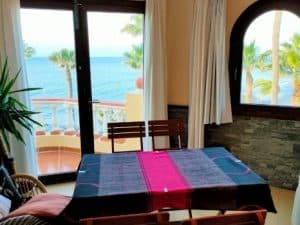Visit Fort La Latte
You enter Fort La Latte castle via two draw bridges at 60 meters above the sea. A cannonball oven was built in 1793, one of which can still be seen on the walk at Cap d'Erquy and Lacs Bleus. The oven was used to heat the cannon balls before firing them at the ships. The castle consists of two ring walls. After you cross the first drawbridge, you will come to the first courtyard. From there you can cross the next drawbridge to the main second courtyard.




Here you will find the guardhouse, the commander's house, the chapel, the oven and the watchtower with keep. At the very top of the lookout tower you have a spectacular view of the Côte d'Émeraude. I myself went all the way up (see first photo). When entering the tower and keep a sign hangs with the request to keep children going. I found the last stairs to the viewing platform particularly dangerous. In 1892 the fort became private property and in 1925 a historic landmark, with the fort being opened to the general public. The well (see 2nd photo below) was built in the 14th century. Because the fort is on a rock above the sea, it was impossible to scoop up groundwater. That is why the rainwater from the roofs was diverted to the well.



La Roche Goyon
Thet la latte was built with the help of the Breton Goyon-Matignon family in the 14th century (finished in 1379) and after a looting and arson, it was rebuilt in the 17th century. That is why it sometimes happens La Roche Goyon (Goyon's Rock). It was later restored in the 20th century.
The watchtower 🏹
The tower from the 15th century has three floors and is also called the archer's tower. It owes its name to one of the floors from which terribly long arrows were shot with large crossbows. I can't think about it if you were hit by such an arrow. The basement or lower floor served as forage space to store food in, the second was used as a forage floor and the third with the golden roof as a watchtower. The curved roof was restored at the end of the 17th century.


Parking
You can park for free near the Fort, but you can also park at Cap Fréhel. From Cap Fréhel you can visit Fort La Latte through the beautiful coastal walk to Fort La Latte. About a one-hour walk from Cap Fréhel you will arrive at the castle. Because I like to take photos and make videos on the walks, it took half an hour longer than usual to get there. The time to get back to the car took just one hour.
Parking Fort: 26 La Latte, 22240 Plévenon, France
Opening hours & Admission prices
The entrance fee to the beautifully situated medieval fortress costs 5,5 euros per person (3,5 euros to 12 years), but is certainly worth it. Extra information
April-May-June-September: 10.30-18.00
July August: 10.30-19.00
October-November 15: 14.00-18.00
Fort La Latte as a film set
The castle was used as a film set in Richard Fleischer's 1958 film "The Vikings", starring recently deceased actor Kirk Douglas (09/12 / 1916-05 / 02/2020) and Tony Curtis (+ 2010). It is a bit strange that the Fort (13th-14th century) was used as a location for a Viking film, because the castle was not yet built in the time of the Vikings (789-1066). 🤦️️



